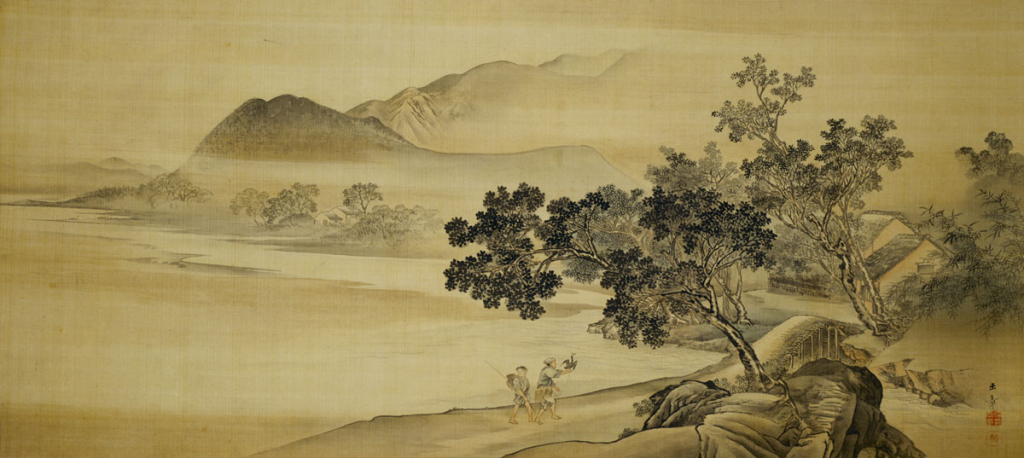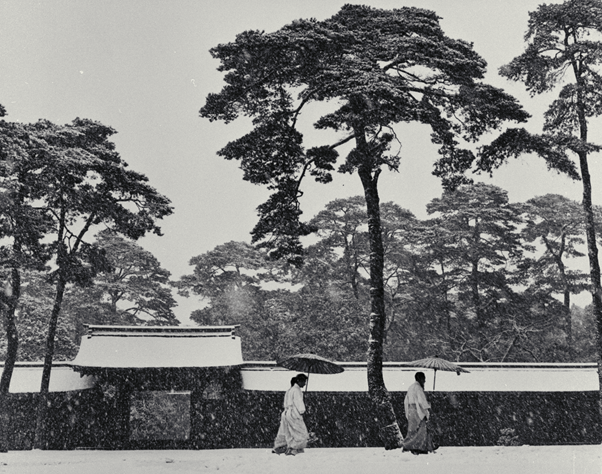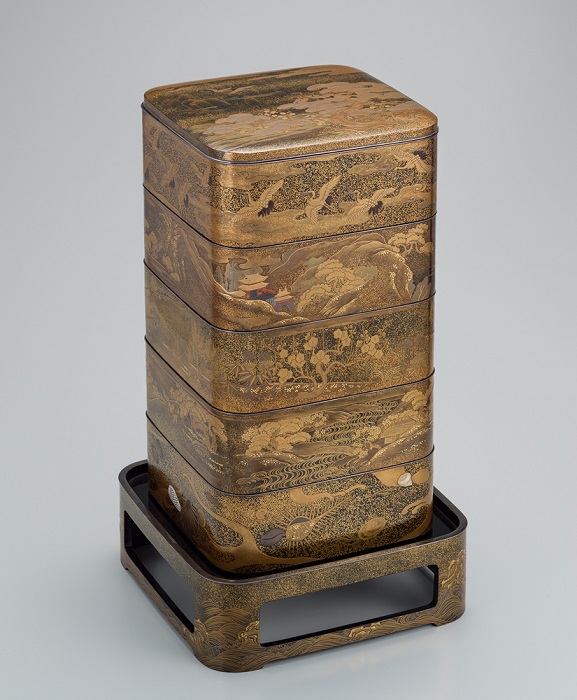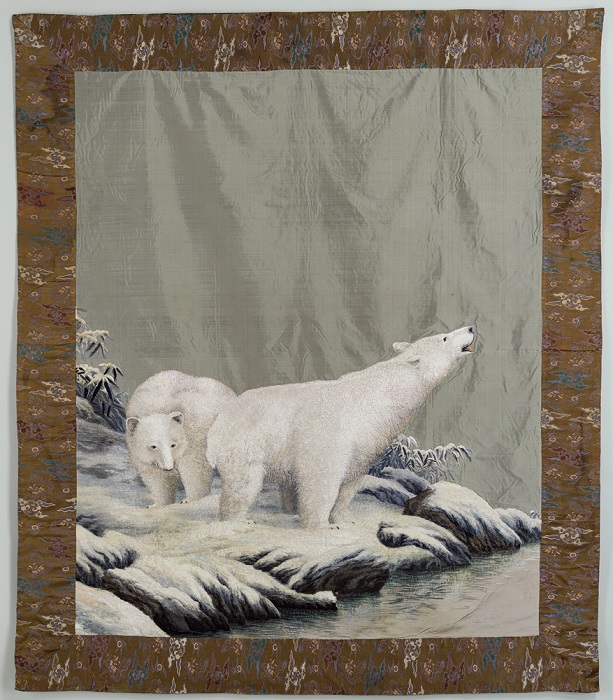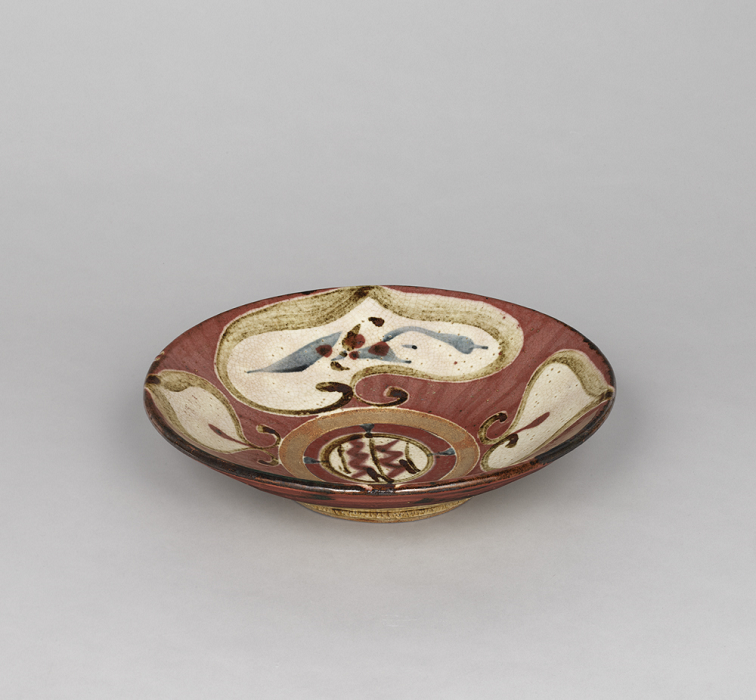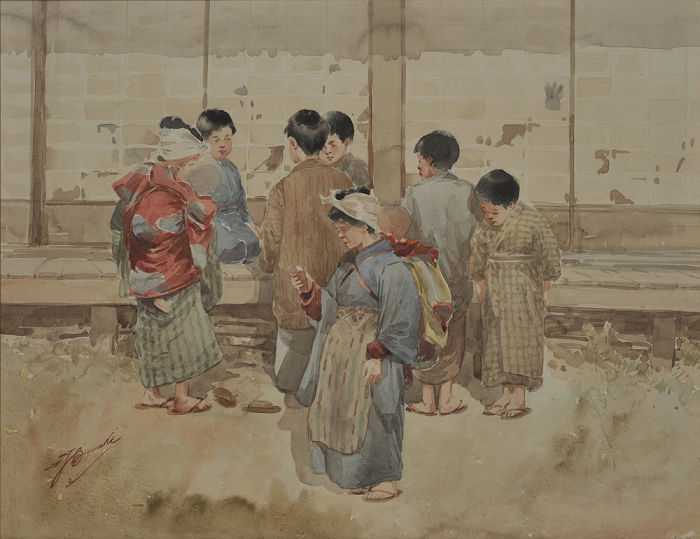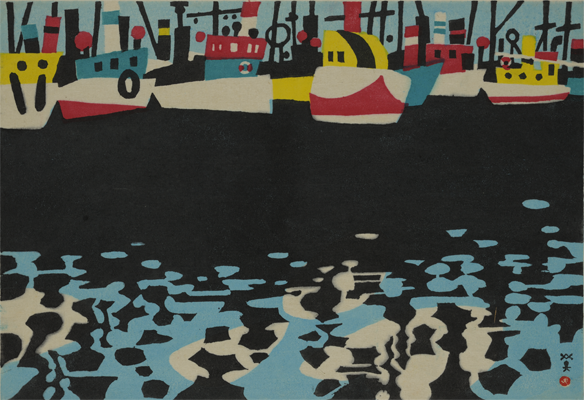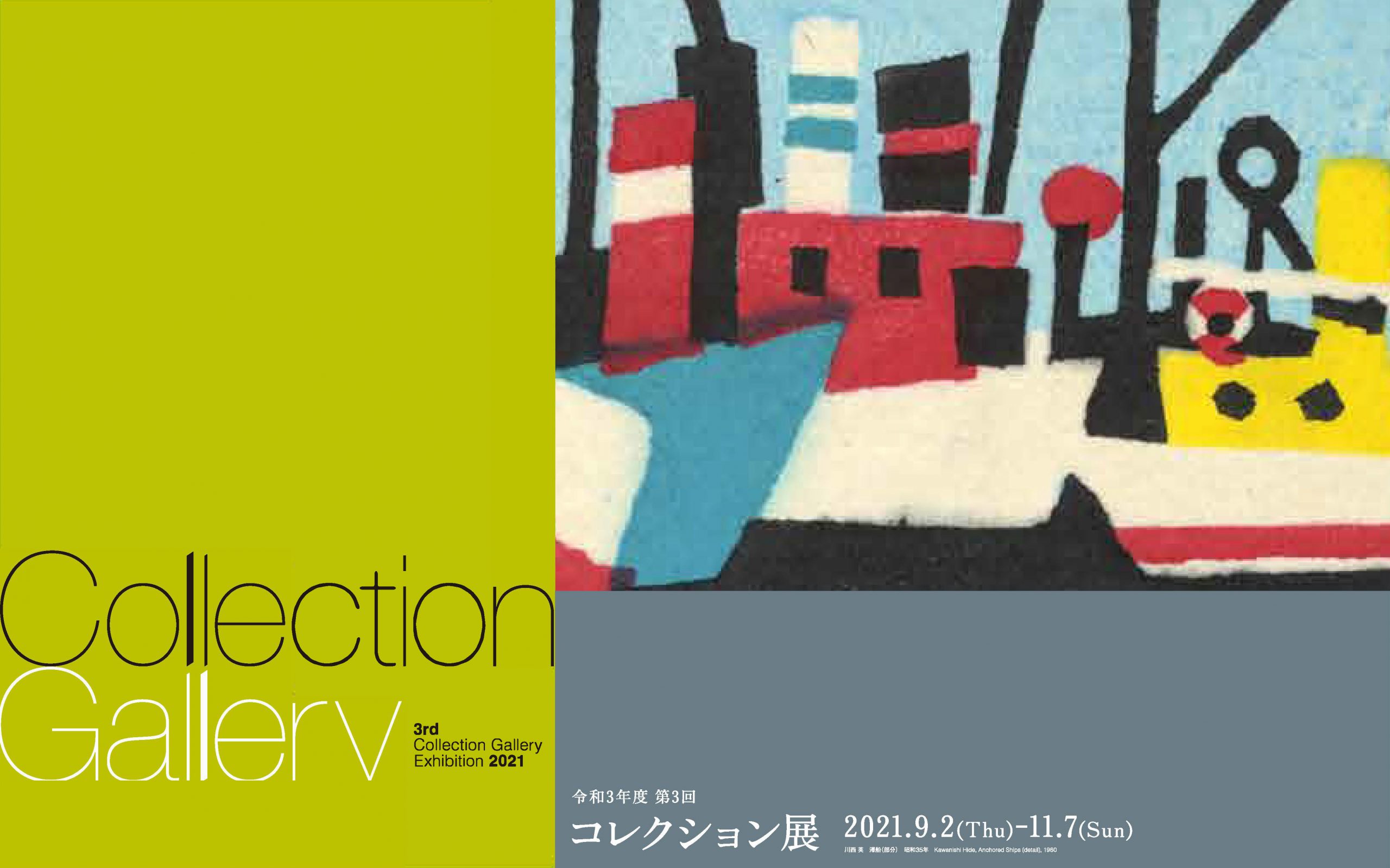
Collection Gallery
3rd Collection Gallery Exhibition 2021–2022
2021.09.02 thu. - 11.07 sun.
Selected Works of Western Modern Art
This area features selected works of Western modern art from our collection or deposited to the museum. During the current term, we are pleased to present waterside scenes in which a wide variety of vessels are at anchor.
Eugène Boudin was not only a pioneer in the new field of maritime art, depicting scenes of seaside communities transformed through modernization from fishing villages to summer resorts for city dwellers, but also devoted himself to working outdoors so as to capture the changing light of sea and sky, rendering nature in a way that strongly influenced Impressionists such as Claude Monet. This work was produced in Belgium in 1870-71, where the artist was staying to avoid the Franco-Prussian War. Its subject is the delta of the Scheldt River (known in French as the Escaut) flowing through Antwerp, with smoke rising from a factory and a large sailing ship in the background, and a small boat and a fisherman in the foreground. The position of the horizon is low, and the expanse of the sky fills most of the picture. With its understated contrasting of old-fashioned and modern-day scenery and rendering of fleeting clouds about to change form, it is a fine embodiment of Boudin’s unique artistic personality.
The painter Alfred Sisley was labeled “a true Impressionist” for his lifelong dedication to faithfully capturing changes in the light and air of the surrounding natural environment. In most cases he applied paint directly and spontaneously to the canvas, and evidently made no subsequent changes in the studio. This painting, depicting the riverside at Bougival on the left bank of Seine about 18 km from Paris, has one of Sisley’s distinctive compositions in which the gently curving river, path, and trees guide the viewer’s gaze into the distance, and two small boats almost in the center of the picture connect the townscape of Bougival in the background with the natural scenery in the foreground. The river reflects clouds and light in the sky above, and light rose and mauve tones on the surface convey the warm, gentle stirrings of nature to the viewer. This is considered to be a study for, or work related to, The Seine at Bougival (1873, collection of the Denver Art Museum), which features a similar composition, extended to the left and right.
Paul Signac is recognized along with Georges Seurat as a leading painter of the Neo-Impressionist school, which sought to represent light using distinct dots of color in the scientifically based technique known as pointillism. However, Signac aimed to produce even more brilliant light effects than those of Impressionism, and used larger, rougher brushstrokes than the initially small dots of pointillism. This resulted in slight white spaces between the strokes, with adjacent spots of color remaining unblended, and the painting as a whole takes on a transparent, mosaic-like decorative look. This work depicting Saint-Tropez, a port city in southern France where Signac was fond of staying, brims with the crisp, dry light of the Mediterranean. The sails of boats glowing orange in the sun and the blue of the sea on which they float are particularly eye-catching. This work is exemplary of the achievements of Signac, who broke away from strict Neo-Impressionism and paved the way for the blazingly vivid palettes of Fauvism.
Albert Marquet stands alongside Henri Matisse and others as one of the most prominent Fauvist painters, but is known less for vibrant colors than for poetic landscapes rendered in soft, neutral tones. The scenery of the port of Algiers in North Africa, depicted in this painting, was one of Marquet’s favorite subjects. As World War II raged in Europe, Marquet and his wife left Paris for Algiers in 1940 and lived in an apartment overlooking the city until 1941. Like many of Marquet’s works, this one presents a panoramic view, with a customs building and small fishing boats in the foreground, and Algiers Bay with large cruise ships berthed and the expanse of the sky are rendered in a bold diagonal composition. The colors of sea and sky, infused with Marquet’s distinctive pale, grayish translucent blue-green, convey the lazy atmosphere of a harbor where the wind has stilled.
Nihonga Paintings of the Meiji and Taisho Periods KAWABATA Gyokusho, Cormorants Fishing in Tama River, n.d.
The Meiji Restoration of 1868 struck a severe blow to Kyoto-based painters. As Japan’s capital and the seat of Imperial power was transferred to Tokyo, many people who underpinned the economy of Kyoto also moved there, and the number of commissions for Nihonga (modern Japanese-style) paintings plummeted. At the same time, Japanese crafts were attracting attention overseas, and painters found new career opportunities in the creation of craft designs, with some such as Asai Chu enthusiastically devoting themselves to the field. However, literati painting was something of an exception, and because Meiji government bureaucrats and intellectuals were well versed in classical Chinese studies and fond of literati painting, it remained a popular genre in the new era as it had been in the final days of the Tokugawa Shogunate. Nihonga paintings of the early Meiji Era (1868-1912) featured many themes and styles carried over from the Edo Period (1603-1868), while the late Meiji Era saw a rise in new styles that showed the influence of Western painting.
Meanwhile, in Tokyo, the ongoing modernization of painting was spearheaded by artists such as Ernest Fenollosa and Okakura Tenshin, and 1889 saw the opening of Tokyo Fine Arts School, graduates of which included Yokoyama Taikan, Shimomura Kanzan, and Hishida Shunso. After Okakura resigned from Tokyo Fine Arts School in 1898 and founded Nihon Bijutsuin (the Japan Art Institute), they joined him in his pursuit of innovation in Nihonga. The techniques of Yokoyama, Hishida and associates at this time were derided as morotai (lit. “vague style”), but their elimination of lines and use of karabake (dry brushes) to produce smooth gradations was a breakthrough in vivid expression of moist atmosphere and light.
In the Taisho Era (1912-1926), the development of a capitalist economy led to the emergence of industrialists and the wealthy class, who became painters’ new patrons. Also, popular movements such as “Taisho democracy” were unfolding, and painters also sought freedom of expression and respect for their individuality.
Time Regained: Selections from the Photography Collection Werner BISCHOF, Shinto Priests in the Temple Garden, Meiji Shrine, Tokyo, 1952
In the early 19th century, when the British scientist William Henry Fox Talbot visited the shores of Lake Como in Italy, he attempted to sketch a beautiful landscape with the aid of the optical device known as a camera lucida, but was unsatisfied with his own drawing. In search of a method of preserving a projected image on paper, he invented the early photographic technique called Calotype. Photography, invented in Europe, was rapidly incorporated into society and daily life worldwide as a means of documentation and artistic expression. It gave even those without drawing skills a way to record thrilling landscapes, unusual objects, near and dear family members and friends, and even invisible phenomena such as time and movement. Time Regained is the title of one volume of the French novelist Marcel Proust’s magnum opus In Search of Lost Time, but it aptly describes the act of viewing photographs, which enable us to revisit days gone by, share memories with others, or awaken other memories slumbering within us.
MoMAK’s acquisitions of photographic works began in 1986 with Kyocera Corporation’s gift of the Arnold Gilbert Collection, containing 1,050 photographs. This collection was assembled by Arnold and Temmie Gilbert, residents of Chicago, USA, between the late 1960s and the 1980s.
The collection is characterized by a historical-overview approach to photography, and includes a number of rare original prints that are evidence of direct interaction between the Gilberts and legendary modern American photographers. In this exhibition, we primarily present works from the very early days of photography and other selections, mainly landscapes, from the museum’s photography collection.
Meiji Period Crafts Tiered Boxes with Design of Mountains and Sea of the Four Seasons, Maki-e, late Meiji-early Showa era Tapestry of Silk Embroidery with Polar Bears, 1868-1912
Meiji Era (1868-1912) crafts, prized for their stunning artistic and technical wizardry, have surged in popularity in recent years and are undergoing critical reappraisal. Certainly these decorative works are exquisitely detailed and include realistic renderings nearly indistinguishable from the actual item, and one cannot help but be astounded at the sensitivity and skill of the creators. However, Meiji crafts have been virtually omitted from the Japanese art-historical narrative for many years. The main reason is that many of the works were exported overseas through World’s Fairs and art dealers, and not many top-quality pieces remained in Japan. It has been difficult to dispel prejudice against the ones left behind, which tended to be viewed as excessively decorative, too focused on technique, and deficient in true Japanese aesthetic values and characteristics. However, as the study of modern art history and the purchase and repatriation of works from overseas has progressed, there have been more opportunities to see works of the highest caliber, and the overly decorative and technical qualities regarded as grounds for dismissal of these works are now seen in terms of continuity with the technical approaches of previous generations. It has also become clear that Meiji artists were avidly gathering information from overseas, absorbing the latest techniques and styles, and making improvements based on their own artistic intent. It should be noted that Meiji crafts originated after the Meiji Restoration of the 1860s and the collapse of the Edo system of domains governed by the Tokugawa Shogunate, when artisans of the Meiji Era lost the backing of domain rulers they had enjoyed thus far and had to apply the techniques they had mastered in a manner appropriate for the new era. These artisans established a distinctive style of Meiji crafts, which involved rendering their technical wizardry itself visible. For this reason Meiji crafts are now being re-contextualized in art history, as a crucial link between pre-modern and modern times.
Selected Works of KAWAI Kanjiro from the Kawakatsu Collection KAWAI Kanjiro, Copper Red Bowl of Water Caltrop Design, 1941
The Kawakatsu Collection, which includes a grand-prize winning piece from the 1937 Paris International Exposition, constitutes the most substantial public collection of Kawai Kanjiro’s works in terms of both quality and quantity.
The collection was donated to the museum by the businessman Kawakatsu Kenichi in 1968. When a museum curator went to see Kawakatsu’s huge collection of Kawai’s works, which placed an entire space of his house, he said, “Choose as many as you like.” In the end, 415 items were selected. Along with three pieces that Kawakatsu had previously donated to the museum and seven others that were subsequently added to address a lack of Kawai’s early works, the collection eventually totaled 425 works. Made up of important works by the artist, stretching from his first efforts, which were modeled on Chinese porcelain, to his final pieces, made after his involvement with the Mingei movement, the collection is truly a chronological encyclopedia of Kawai’s ceramics that spans his entire career.
Kawakatsu (1892-1979), who assembled the collection, worked as the advertising manager at the Tokyo branch of Takashimaya Department Store as well as serving as the store’s general manager, and the senior managing director of the Yokohama branch. In his role as a member of the Ministry of Commerce and Industry’s craft examination committee, he also strove to foster craft designs.
Kawai’s long friendship with Kawakatsu began when he went to meet the artist at the station when Kawai traveled to Tokyo for a meeting regarding the 1st Creative Ceramics Exhibition, which was held at Takashimaya in 1921. Immediately sensing that they were kindred spirits, Kawakatsu began collecting Kawai’s works. Reminiscing about the collection, Kawakatsu said, “It wasn’t merely based on my personal taste. Sometimes Kawai would make works for the collection and he also chose lots of pieces for it.” He added, “It was the crystallization of our friendship.”
Scenes from the Meiji Period YAMADA Basuke, A Sunny Day, late Meiji era
From September 7 to October 31, we are pleased to present the exhibition Japanese Landscapes Discovered on the third floor of the museum. It features works by painters from Western countries including Britain who traveled to Japan during the Meiji era (1868-1912) and depicted the scenery and customs of the time, along with contemporaneous works by Japanese painters depicting similar subjects, taking the viewer on a journey through the landscapes and lifestyles of Japan in those days. All of these works were acquired overseas by a single art collector, in Britain and elsewhere, and part of the exhibition's appeal lies in the fact that most of these works have never been exhibited in Japan before.
To celebrate this special event we are also presenting works from our collection, dating from the same era, in this related exhibit, Scenes from the Meiji Period.
Among the artists whose works are shown here, Yoshida Hiroshi, Oshita Tojiro, and Watanabe Hoshu are also prominently featured in Japanese Landscapes Discovered, but others such as Ito Yasuhiko, Kato Gennosuke, Hasegawa Yoshio, Tanaka Zennosuke, and Shimotori Yukihiko are not included in the special exhibition and their works can only be seen here. Ito, Kato, Hasegawa, and Tanaka were all painters from Kyoto, and while Shimotori hailed from Tokyo he was active in Kyoto, so the presence of their works can be said to illuminate a distinctive aspect of the museum's collection.
One must-see highlight of this exhibit is the oil painting Onjuku Beach by Asai Chu, who spent his last five years in Kyoto and was an enormous influence on the city's modern arts and crafts. For many years, this masterwork was frequently reproduced in art books but its whereabouts were unclear, though it was known to exist somewhere. Please take this opportunity to be one of the first to view this noteworthy new museum acquisition in person.
Landscape Prints of Kyoto, Osaka, Kobe, and Tokyo Featuring Works by KAWANISHI Hide KAWANISHI Hide, Anchored Ships, 1960
In connection with the special exhibition Japanese Landscapes Discovered on the 3rd floor, we are pleased to present a number of landscape-themed prints from our collection. The special exhibition focuses on Japan in the Meiji era (1868-1912), but here we have brought together works from the Taisho (1912-1926) and Showa (1926-1989) eras, particularly those depicting the Kyoto-Osaka-Kobe area, where the museum is located, and Tokyo.
On view in an area dedicated to Kyoto and Osaka are works by lithographer Oda Kazuma (1882-1956), one of the founders, along with Yamamoto Kanae, Tobari Kogan, and Terasaki Takeo, of Nihon Sosaku-hanga Kyokai (the Japan Creative Print Art Association), which advocated “self-drawn, self-carved, self-printed” prints. Kawanishi Hide (1894-1965), known for prints of Kobe scenery and circus scenes, exhibited with the association starting in 1922 (with his work first selected for exhibition the following year). Kawanishi taught himself the techniques of woodblock printmaking, but through participation in the association he met Kitamura Imazo (1900-1946) and Harumura Tadao (1901-1977), woodblock printmakers who had attended the nearby college (today a university) Kwansei Gakuin. In 1929 he formed Sanko-kai, a group of printmakers from Kobe, and he went on to organize exhibitions and show many ambitious works, becoming ever more widely known. The museum possesses approximately 1,000 works and materials acquired by Kawanishi Hide, known as the Kawanishi Hide Collection, including the works by Kitamura, Harumura, and Kawakami Sumio shown in this exhibit. Kawanishi Yuzaburo (1923-2014), whose works are on view in an Osaka-themed area, was the third son of Kawanishi Hide, a graduate of Kwansei Gakuin and a junior of Kitamura and Harumura. We hope you enjoy these landscapes from eras and depicting places that are close to our own, and that they evoke nostalgic memories as well as illuminating relationships among the artists.
Exhibition Period
2021.09.02 thu. - 11.07 sun.
Themes of Exhibition
Selected Works of Western Modern Art
Nihonga Paintings of the Meiji and Taisho Periods
Time Regained: Selections from the Photography Collection
Meiji Period Crafts
Selected Works of KAWAI Kanjiro from the Kawakatsu Collection
Scenes from the Meiji Period
Landscape Prints of Kyoto, Osaka, Kobe, and Tokyo Featuring Works by KAWANISHI Hide
[Outside] Outdoor Sculptures
List of Works
3rd Collection Gallery Exhibition 2021–2022 (261 works in all) (PDF 335KB)
Free Audio Guide App
How to use Free Audio Guide (PDF)
Hours
9:30AM–5:00PM
*Fridays and Saturdays: 9:30AM–8:00PM
*Admission until 30 min. before closing
*Opening hours is subject to change, due to the prevention against COVID-19 pandemic. Please check the updated information, before your visit.
Admission
Adult: 430 yen (220 yen)
University students: 130 yen (70 yen)
High school students or younger,seniors (65 and over): Free
*Figures in parentheses are for groups of 20 or more.
Collection Gallery Free Admission Days
September 4, November 3, 6, 2021
Free Audio Guide App How to use Free Audio Guide (PDF)



